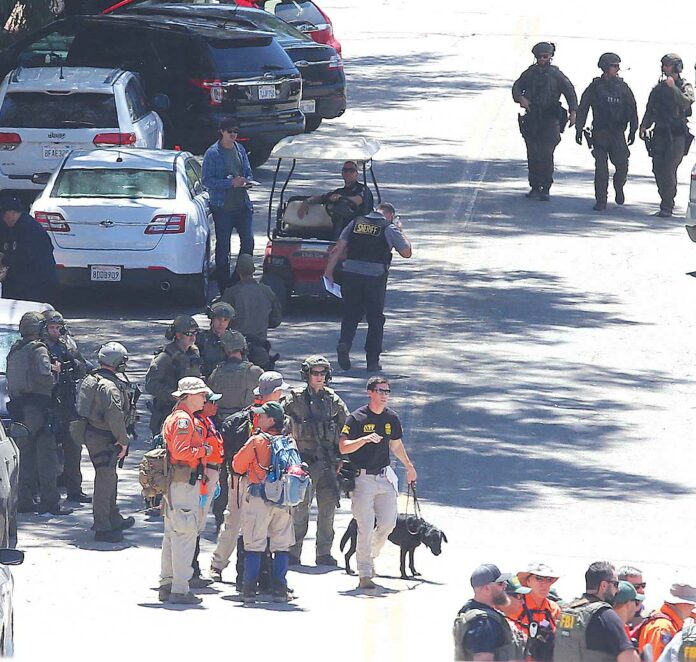
Editor’s note: This article was updated to reflect the court’s Nov. 16 decision to finalize the decision, as well as additional statements.
A Santa Clara County Superior Court judge ruled Nov. 14 that attorneys representing victims of the 2019 Gilroy Garlic Festival mass shooting provided insufficient evidence to take the case to a trial.
The victims plan to appeal the decision. They say it sets a bad precedent for security measures at future events.
Judge Frederick S. Chung granted the summary judgment motions of defendants City of Gilroy, Gilroy Garlic Festival Association and First Alarm Security & Patrol, dismissing them as defendants from the lawsuit. A summary judgment means the facts are not disputed, eliminating the need for a trial.
Following the July 28, 2019 shooting that killed three people and injured 17 others, Wendy Towner of Los Gatos, a vendor at the event who was struck by gunfire, joined other victims in filing a lawsuit against the city, festival association and security company on Nov. 12, 2019, alleging negligence on the part of the organizers for not maintaining a safe event. The lawsuit was later amended to add more victims, as well as complaints for wrongful death.
The three attendees who were killed were: Stephen Romero, 6, of San Jose; Keyla Salazar, 13, of San Jose; and Trevor Irby, 25, visiting from New York.
In 2021, Century Arms, the manufacturer of the gun used in the shooting, was added as a defendant to the complaint, alleging negligence. Chung quashed the complaint against Century Arms on Nov. 7.
On Dec. 16, 2022, the city, GGFA and First Alarm filed motions for summary judgment.
In its motion with submitted evidence and statements from city and police officials, the city stated that the fence that shooter Santino Legan allegedly entered through at Christmas Hill Park, as well as the foliage and parked vehicles near it, were not “dangerous conditions of public property” as alleged by the plaintiffs. Among other things, the city stated that it had “no actual or constructive knowledge of the alleged dangerous conditions of public property,” and the shooter’s act was “completely unforeseeable.”
In his ruling, which was finalized on Nov. 16, Chung wrote that the city’s evidence was “sufficient…to establish that no dangerous condition of public property existed,” and any gaps in the fencing noticed by law enforcement “were called in and addressed by the other defendants; they were not the City’s responsibility.”
“The lack of any evidence of prior incidents of gun violence at the Festival in prior years is sufficient to show that, even if the City were responsible for the ‘perimeter barriers,’ a mass shooting incident was not a reasonably foreseeable risk of that particular physical condition that would support a claim for dangerous condition of public property,” Chung wrote, adding that the plaintiffs’ argument is “unpersuasive.”
In its motion, the GGFA stated it “did not owe Plaintiffs a duty to prevent an unforeseeable mass shooting” as its employees did not “create the alleged dangerous condition of public property and it did not have actual or constructive knowledge of the alleged dangerous condition of public property.”
Chung agreed, and said that the plaintiffs’ claim that the festival’s “history of violence and criminality” based on knives being confiscated at the front gate or fights breaking out on the grounds “do not come close to demonstrating that the July 28, 2019 shooting itself was reasonably foreseeable.”
The victims’ complaint against First Alarm, which provided security at the festival, claims that it offered “inadequate security measures and training.”
Chung repeated his reasons for granting the city’s and GGFA’s motion, writing that First Alarm could not have foreseen the mass shooting.
Randall Scarlett of Scarlett Law Group, representing the victims, plans to appeal.
“His opinion should shock all Californians,” Scarlett said of Chung’s ruling. “This sets a precedent that any organizer of a large-scale event in California cannot be held liable for damages related to a shooting unless they had a shooting already. In order to hold them responsible, they had to have had gun violence at their event earlier in order to take protective measures.”
Scarlett said witness statements revealed that Legan was spotted at the festival on the Friday before the shooting, “obviously looking for weak spots.” While it is unknown if he was there on Saturday, Legan was reportedly identified by one of his former teachers walking the festival grounds about 15 minutes before the shooting on Sunday, wearing long sleeves and pants during the hot weather and acting “not normal,” Scarlett noted.
Officials also knew about the broken fence on Friday that Legan reportedly entered through near Uvas Creek two days later, according to Scarlett, and someone had put zip ties to keep it shut. But nobody wanted to take responsibility to fix it, he added.
Scarlett said that once the appeal is filed, he expects the appellate court to “handle it promptly” and determine the decision was made in error.
“Why even have a fence? Why even have wanding? Why do any of that if they can’t be held responsible?” he said. “The judge took the case away from a Santa Clara County jury. I would rather have a jury of my peers tell us what kind of security these organizers should utilize at their events rather than have a judge make that call solely.”
Scarlett added that the victims are not asking for a dollar amount to come from the lawsuit. But they are still grieving and suffering from post-traumatic stress disorder as well as costly surgeries, he noted, saying that Towner’s medical bills alone in 2022 were nearly $2 million.
In a statement, the Gilroy Garlic Festival Association said “Our hearts continue to be with those affected by the devastating events of July 28, 2019. The pain and loss experienced by the victims, their families and our community are still evident, and our deepest sympathies remain with all.”
The association added that it respected the court’s “lengthy legal process and thorough examination,” noting that the judge’s determination “reflects the complexities inherent in such cases.”
City officials responded to the ruling in Nov. 17 statements.
“We respect the court’s decision to grant the city’s motion for summary judgment,” City Administrator Jimmy Forbis said. “This ruling confirms what the city has felt all along that it held no responsibility for the actions of the shooter. This judgment is an important step for the city at large and our organization to continue to mourn and heal.”
“While we are grateful to put this lawsuit behind us, we remain profoundly empathetic towards all individuals and families impacted by the Gilroy Garlic Festival incident and this longtime impending case,” Mayor Marie Blankley said. “We recognize the emotional and personal complexities involved and remain committed to our values of compassion, respect and genuine concern for all.”
City of Gilroy spokesperson Rachelle Bedell said there are no other cases pending against the city.
Scarlett is also the lead attorney for another case against all the same defendants except the city. That case, “Tamara Williams vs. Gilroy Garlic Festival Association, Inc. et al,” filed in January 2022, continues to wind through the court, with a case management conference scheduled for March 2024.







